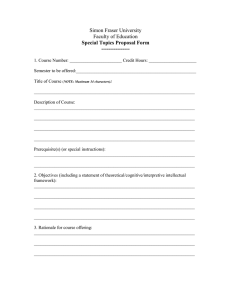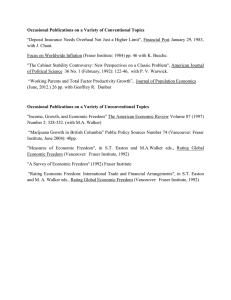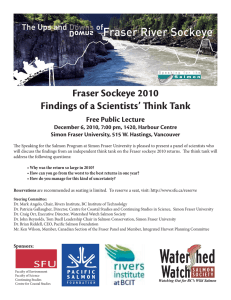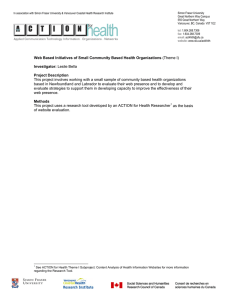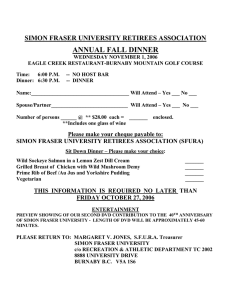Costs of the War on Drugs Richard Stevenson
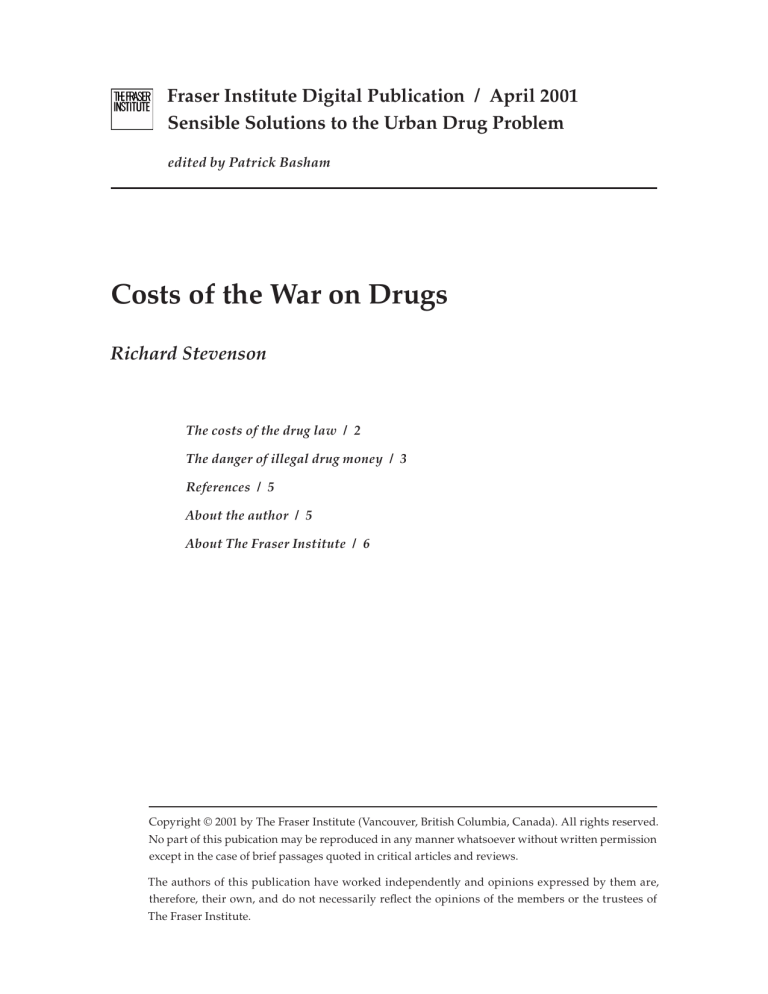
Fraser Institute Digital Publication / April 2001
Sensible Solutions to the Urban Drug Problem edited by Patrick Basham
Costs of the War on Drugs
Richard Stevenson
The costs of the drug law / 2
The danger of illegal drug money / 3
References / 5
About the author / 5
About The Fraser Institute / 6
Copyright © 2001 by The Fraser Institute (Vancouver, British Columbia, Canada). All rights reserved.
No part of this pubication may be reproduced in any manner whatsoever without written permission except in the case of brief passages quoted in critical articles and reviews.
The authors of this publication have worked independently and opinions expressed by them are, therefore, their own, and do not necessarily refl ect the opinions of the members or the trustees of
The Fraser Institute.
Costs of the War on Drugs 2
Costs of the war on drugs
President Nixon declared war on drugs more than 25 years ago. Since then, hundreds of heads of state and senior politicians have agreed that drug issues rank fi rst in the problems facing many countries. Yet, drug problems have intensifi ed and proliferated.
In 1973, illegal drug use was largely an American sport; now it is global.
A British perspective is contained in Tackling Drugs to Build a Better Britain (Central
Drugs Co-ordination Unit 1998). In a document better researched and more thoughtful than its predecessors, there is much that will give satisfaction to those who work in the drug fi eld. For example, the therapeutic value of cannabis is acknowledged and the use of alcohol by children is recognized as a matter of at least as much concern as are illegal drugs.
In other respects, Tackling Drugs presents a familiar story. Demand continues to rise and drug seizures have increased fi ve-fold in the past ten years. If drug law were effective, prices might also be expected to rise. In fact, prices have shown no trend in real terms until recently: the price of heroin is now tending to fall. The conclusion seems unavoidable, as it has been for 20 years (Peltzman 1989). The enforcement agencies are becoming more effective but the productivity of criminal producers and distributors is growing still more rapidly. It is most likely that a similar story could be told about Canada and most other western countries.
Particularly striking in Tackling Drugs is the statement that “there can be no realistic expectation of eradicating supply while a strong demand exists to make profi table opportunities for traffi ckers” (37). This realism, novel in a Government document, is tantamount to an admission that legal prohibition is fundamentally fl awed.
International drug law is based on the proposition that it is possible to buck a market in illegal drugs that accounts for at least eight percent of world trade (United Nations
1997). If the same proposition were applied to any other trade of similar magnitude and profi tability, it would be dismissed as ludicrous by all of those politicians who enlisted for the Drug War.
The costs of drug law
Drug policy is expensive as well as ineffective. Several propositions can be made about these costs that seem to be true for Canada, the United Kingdom, the United States, and most European countries except The Netherlands. Government expenditure is very
Fraser Institute Digital Publication / April 2001
Sensible Solutions to the Urban Drug Problem
Costs of the War on Drugs 3 largely directed to the enforcement of drug law. In the United Kingdom, Tackling Drugs puts the direct total cost of drug policy to the Government at £1.4 billion per year. Of this, 75 percent is spent on enforcing drug law in the United Kingdom and overseas.
The other 25 percent is spent on actual drug problems—education, prevention, treatment and rehabilitation. Of course, these direct costs are only a fraction of the total.
Some part of the total is captured in the Government estimate of social and economic costs of drug use, which is put at £3 to £4 billions annually. The basis for this estimate is not indicated but a high proportion of the social and economic costs are attributable to drug law and the pursuit of illegal drug money rather than the chemical properties of illegal substances.
Some of these costs are found in medicine and public health. No one doubts that illegality makes drug use more hazardous than it need be (Miron and Zweibel 1995). In clandestine markets, the nature and purity of drugs are unknown. An undetected increase in the purity of heroin has been responsible for a spate of overdoses, most recently in
Glasgow during July 1998. Users are reluctant to seek medical advice, except in emergencies. Illegality drives users towards the more dangerous methods of ingestion and unhygienic settings. Harm reduction techniques introduced in the 1980s and changes in behaviour are held responsible for the decline in the HIV prevalence rate but hepatitis, variants B and C, remain a serious risk to public health. The cost of drug law also spills over in all manner of ways to innocent third parties—not least the taxpayer. Costs are found in burglary, sometimes aggravated, the fear of theft and violence, and the costs of averting theft.
The danger of illegal drug money
There is another sort of cost, not readily quantifi able, but perhaps in the long-term more important than all the rest. This cost is sometimes described as the wear and tear on institutions that tends to undermine the authority of the law and ultimately threatens political institutions. The governments of the world have handed to criminals profi ts worth billions of pounds annually but there is a catch. Criminal fi rms are denied the use of normal corporate strategies. One would not wish to express strong sympathy for drug dealers but consider the situation from their point of view.
In illegal trades, contracts do not have the backing of the law. Disputes cannot be settled or debts recovered by appeal to the courts. Firms cannot compete by normal means.
Drug dealers cannot use the media to advertise new products, special offers or “autumn sales.” The concept of the “dawn raid” takes on special meaning when fi rms are not quoted on stock exchanges and are illegal. In the absence of normal competitive processes, fi rms protect and expand their markets by the use of violence or the threat of violence (Miron and Zweibel 1995).
Fraser Institute Digital Publication / April 2001
Sensible Solutions to the Urban Drug Problem
Costs of the War on Drugs 4
In countries such as Peru, Afghanistan, Laos and Cambodia, drug profi ts have fuelled armed insurrection. In parts of South America, some illegal drug fi rms command more resources than some governments. In Colombia, judges, ministers and three presidential candidates have been killed. In the Caribbean, whole political systems and enforcement agencies have been corrupted by drug money. Mexican drug dealers are said to constitute a “parallel government.” All over the world, policemen are killed and, in the
United States, half of all murders are said to be drug-related. In Italy, Judge Falconi was murdered. As Milton Friedman puts it, “all of these atrocities occur because the United
States and other Western countries pass anti-drug laws which they cannot enforce” (Trebach and Zeese 1992).
Most people, aware of the situation in Colombia, Bolivia, Russia, and Italy, would suppose it could never happen in Canada or in the United Kingdom. However, in recent years there has been evidence of changes in the drug trade that give one pause for thought. In May 1995, Chief Superintendent Roy Walker of the Merseyside Police spoke of a “new brutality” in the drug trades of most big cities (Panorama 1995). Drug dealers are increasingly likely to carry fi re-arms and weapons such as machetes, which infl ict injuries of a type and magnitude previously unknown to accident and emergency departments in British hospitals. Victims, maimed or horribly burned, will not testify against their attackers.
Drug use and the drug trade are also implicated strongly in the emergence of a socially disaffected under-class. In most cities, the drug trade is said to be concentrated in just a few criminal fi rms. Drug bosses offer employment in areas where legal jobs are hard to obtain. Chief Superintendent Walker speculated that in time, these fi rms may come to support sports organizations and local charities (as has happened in Brazil). Could it be, he wondered, that drug dealers may become the civic leaders and politicians of the future?
Those who would legalize drugs argue that “getting gangsters out of drugs” should be the fi rst priority of drug policy. Legalization that undermined the profi tability of the trade would be the surest and most administratively parsimonious means of achieving this objective (Stevenson 1994). Victory in the drug war is as remote as ever but it may be that the nature of the problem has changed. Legal prohibition has created criminal empires that are large enough to threaten governments. Corruption and violent competition among dealers are entrenched throughout the world. We might do well to consider the possibility that in the long-run, the maintenance of law and order might be of greater importance than the risk of drug addiction.
Fraser Institute Digital Publication / April 2001
Sensible Solutions to the Urban Drug Problem
Costs of the War on Drugs 5
References
Central Drugs Co-ordination Unit (1998). Tackling Drugs to Build a Better Britain. SD1001
(April). London: The Stationery Office.
Miron, Jeffrey A., and Jeffrey Zweibel (1995). The Economic Case against Drug Prohibition. Journal of Economic Perspectives 9, 4: 175–92.
Panorama (1995). Pulp Futures . BBC Television (May 1).
Stevenson, Richard (1994). Winning the War on Drugs: To Legalize or Not? London: Institute of Economic Affairs.
Peltzman, Sam (1989). The Failure of Enforcement. British Journal of Addiction 84: 469–70.
Trebach, A.S., and K.B. Zeese, Eds. (1992). On Liberty and Drugs: Essays on the Free Market and Prohibition . Washington, DC: The Drug Policy Foundation Press.
United Nations (1997). Economic and Social Consequences of Drug Abuse and Illicit Trafficking . UNDCP Technical Series 6. Vienna: UNDCP.
About the author
Richard Stevenson directs the Health Economics Unit and lectures in the Department of Economics at Liverpool University in the United Kingdom. He has done research and has published in many areas of health economics. His interest in illegal drugs stems from concern for the welfare of users and from the study of the economics of neonatal intensive care for low-birthweight infants, some of whom are born addicted to drugs. Publications on drug matters include Winning the War on Drugs: To Legalise or Not? (London: Institute of Economic Affairs, 1994); and Harm Reduction, Rational
Addiction and the Optimal Prescribing of Illegal Drugs ( Contemporary Economic Policy
12 [July 1994]: 101–08).
Fraser Institute Digital Publication / April 2001
Sensible Solutions to the Urban Drug Problem
About The Fraser Institute
The Fraser Institute is an independent Canadian economic and social research and educational organization. It has as its objective the redirection of public attention to the role of competitive markets in providing for the well-being of Canadians. Where markets work, the Institute’s interest lies in trying to discover prospects for improvement. Where markets do not work, its interest lies in fi nding the reasons. Where competitive markets have been replaced by government control, the interest of the Institute lies in documenting objectively the nature of the improvement or deterioration resulting from government intervention. The work of the Institute is assisted by an
Editorial Advisory Board of internationally renowned economists. The Fraser Institute is a national, federally chartered, non-profi t organization fi nanced by the sale of its publications and the tax-deductible contributions from its members, from foundations, and from other supporters; it receives no government funding.
Membership
For information about becoming a member of The Fraser Institute, please contact the
Development Department via e-mail: membership@fraserinstitute.ca; via telephone:
604.688.0221 ext. 586; via fax: 604.688.8539. In Calgary, please contact us via e-mail: paulineh@fraserinstitute.ca; via telephone: 403.216.7175; via fax: 403.234.9010. From
Toronto, please telephone 416.363.6575 or fax 416.601.7322.
Media
For media enquiries, please contact Suzanne Walters, Director of Communications, via e-mail: suzannew@fraserinstitute.ca; via telephone: 604.714.4582 or, from Toronto,
416.363.6575 ext. 582.
Ordering publications
For information about ordering the printed publications of the Fraser Instiute, please contact the book sales coordinator via e-mail: sales@fraserinstitute.ca; via telephone:
604.688.0221 ext. 580 or, toll free, 1.800.665.3558 ext. 580; via fax: 604.688.8539.
Editing, design and production
Lindsey Thomas Martin
Fraser Institute Digital Publication / April 2001
Sensible Solutions to the Urban Drug Problem
